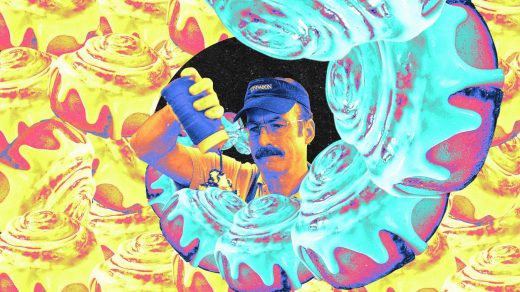How Cinnabon landed its starring role on ‘Better Call Saul’
Branded is a weekly column devoted to the intersection of marketing, business, design, and culture.
Nearly nine years ago, as the series Breaking Bad was drawing to a close, Bob Odenkirk’s character, Saul Goodman, made his great escape from the imminent bust of the drug operation at the heart of the show. “If I’m lucky,” Goodman said, “in a month from now, best-case scenario, I’m managing a Cinnabon in Omaha.”
The line wasn’t exactly flattering to Cinnabon; it kinda treated the familiar mall chain as a punchline. But Cinnabon evidently didn’t see it that way—or, at least, had a sense of humor about it. Either way, the company has leaned in hard to its subsequent association with the fictional, ethically dubious protagonist of Breaking Bad successor show Better Call Saul—and that attitude has proven one of the savviest brand-management decisions in recent memory. Ultimately, it’s become a case study in how a brand can shrewdly navigate its near-accidental association with a notorious pop culture phenomenon.
In fact, Cinnabon is marking the AMC show’s final episode on Monday with a Saul-centric promotion: It’s pushing a coupon code (CALLSAUL) for a buy-one-get-one-free “Center of the Roll” mini-treat offer, available via the chain’s app. In an emailed statement, Michael Alberici, Cinnabon VP and head of marketing, noted: “Our social media team is launching content and engaging with Better Call Saul fans now through the finale, making the most of the time we have before we say goodbye to the series.”
It’s easy to understand why Cinnabon might miss antihero Saul quite a bit. The brand pretty much immediately jumped on the opportunity to amplify its cameo back in 2013: Shortly after that Breaking Bad episode aired, Cinnabon’s official Twitter account tweeted a company careers-page link at Odenkirk. Soon, a sign appeared at a real-life Omaha Cinnabon location, with the Goodman quote.
. @mrbobodenkirk When you’re ready http://t.co/fynwXF6W9c #BreakingBad
— Cinnabon (@Cinnabon) September 23, 2013
“We’re not sure that the line, uttered by criminal lawyer Saul Goodman, is necessarily a compliment to Cinnabon,” Consumerist noted at the time. “But the company has been a good sport about the reference.”
When Better Call Saul debuted, it was mostly a prequel to Breaking Bad, explaining Saul’s back story. But it included snippets of his post-Bad life as, yes, a (markedly joyless) Cinnabon manager in Omaha, renamed Gene Takovic, often ruminating about his past and always looking over his shoulder. (The legend goes that the attention from that throwaway line actually influenced the show’s creators to follow through and literally situate Gene in a Cinnabon.)
For the series’ first five seasons, these passages didn’t exactly seem complimentary either. That said, at least the chain looked professional and clean, the show was a critical smash, and in any case, the scenes were fleeting.
In the recent episodes of the show’s final season, more action has shifted to the present—and thus to Cinnabon Saul. No spoilers for those of you who are late to the Saul phenomenon, but this reached a climax in episode 10, which pretty much depended on the idea of Cinnabon’s 880-calorie flagship roll being irresistible (at least to certain appetites). As the episode’s pivotal pastry glutton exclaims: “Gene, gene, the Cinnabon machine!”
Watching @BetterCallSaul has made me want @Cinnabon more than anything else in the last twenty years. @JimOHeir especially made it look so good.
Hmmm . . . closest one is only ten minutes away . . . pic.twitter.com/k9wsuCMkzO
— Rob Holt, PhD (@HoltScience) August 11, 2022
That was a remarkable moment for the brand, but there was more. The show’s own social media blasts repeatedly emphasized the chain’s gooey charm—and, of course, Cinnabon always amplified them.
While Alberici says Cinnabon has been “working with” Better Call Saul throughout, the company has also said it does not get advance looks at scripts. This can be risky: Outside of a paid placement deal, a brand may not know how its products or services will figure into a storyline—whether it’s the hero of Stranger Things‘ curious fixation on Eggo frozen waffles, or Mr. Big dropping dead after a Peloton bike session in And Just Like That . . ., the Sex and the City sequel.
In essence, Cinnabon has simply trusted in the belief that the show won’t harm the brand, and has thus cooperated with production-related requests. (The Cinnabon scenes are filmed in an Albuquerque mall, with an assist from the company.) “It keeps our brand top of mind for consumers around the world,” Alberici told the New York Times. “We’d be crazy to put stipulations around this opportunity.”
Indeed, as Defector recently noted, the chain has run regular Saul tie-in promotions over the years, sometimes in partnership with AMC. As Alberici has acknowledged, the Saul finale represents a bit of an end-of-an-era moment, and the social media team will be ready to live-tweet as appropriate.
With the benefit of hindsight, Cinnabon’s Saul embrace looks like a no-brainer. But it’s easy to imagine a more protective or at least cautious approach to the initial and subsequent references—maybe not openly objecting to being treated like a punchline, but studiously avoiding the subject. Better Call Saul is, after all, at times an extremely dark show.
But at other times, it’s a very funny one. And perhaps by not only recognizing that, but chiming in with humor of its own, Cinnabon struck the right tone for itself and its accidental role in the series. In a sense, it quietly became a minor member of the cast. And dark or funny, Better Call Saul is definitely a classic, so Cinnabon’s brand cameos are likely to have a long life. The promotions and the social media watercooler buzz will fade. But reruns are forever.
Fast Company , Read Full Story
(26)



